Libya 06 @ Tobruk Site
This is a report on the results of the Sky and Telescope
trip via the MSC Sinfonia to the eclipse site south of Tobruk, Libya.
First Let me thank our Libyan guides, security
personal, and the people of Libya. All of the visitors from the MSC
Sinfonia felt welcome and safe. Hopefully this exchange will help
foster understanding between our two peoples.
Quick Summary
Details on the Site
We traveled to Libya on the Sky and Telescope
trip aboard the MSC Sinfonia arriving in Tobruk harbor Tuesday evening.
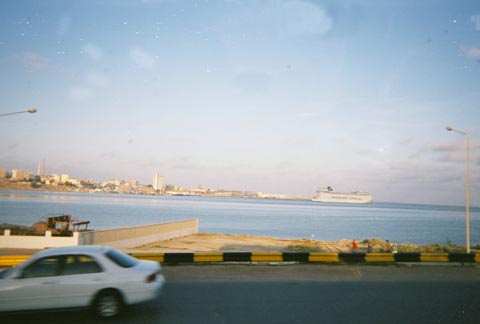
MSC Sinfonia in Tobruk harbor
About 60 of us decided to travel to the site the night before and sleep
out there. In principle this would avoid problems the next day
getting to the site and would allow us to polar align our
equipment. The site was about 2 hours south along the road to Al
Jaghbub.

Espanak,etal NASA/TP--2004-212762
Our overnight accommodations were a tent camp set up
specifically for our group and one other. Our hosts provided us
with dinner and some of the nearby residents provided a program of
music and local dance.
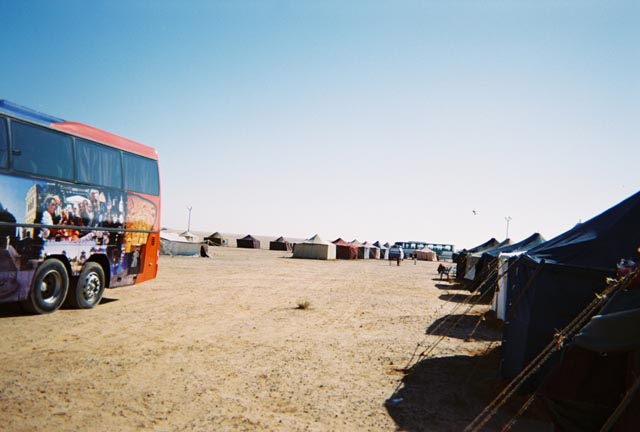
The next morning we were told that the viewing site was in a different
location further from the road. We packed up and headed inland
about 2 kilometers.
The site there was like no other eclipse site I have been to. I
heard estimates that almost 2000 people from the boat and other groups
were bused to the site. There were people stretching into the distance
plus Libyan TV, boy scouts, and other local groups.
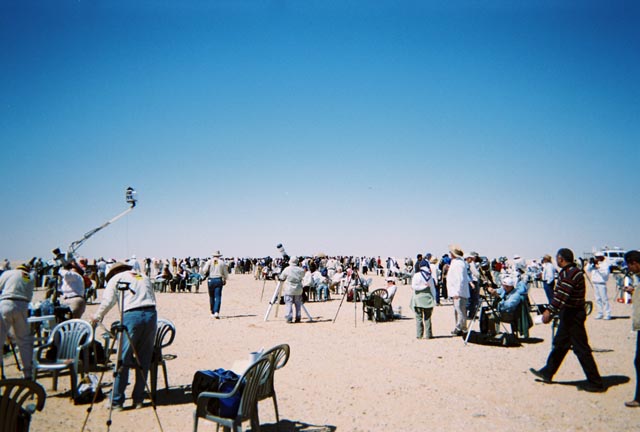
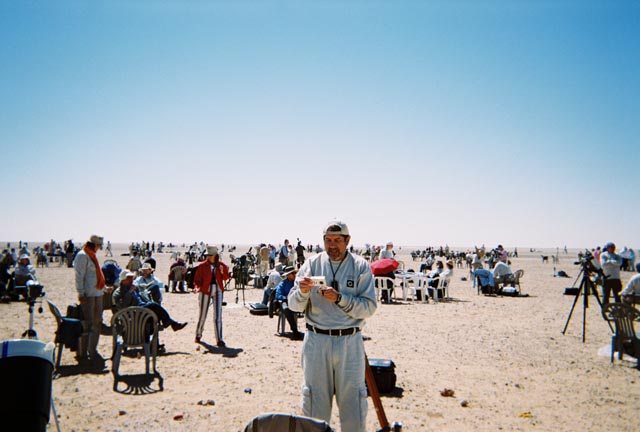
The coordinates of the new site were 30° 57.577' N
24° 16.852' E. The estimated event times were by the Javascript
Eclipse Calculator to be
1st Contact
|
09:17:43.7 UTC
|
2nd Contact
|
10:35:44.0
|
3rd Contact
|
10:39:43.5
|
4th Contact
|
11:57:56.4
|
The surface was hard packed dirt with a layer of rocks on top and
clearly windblown. It was flat extending to the horizon in all
directions. It evoked thoughts of the Utah Salt flats more then
the traditional view of Sahara as sandy dunes.
It
had rained a couple of days before which probably reduced the dust.
Equipment
This was my sixth eclipse. The last two were on the sea and both
had problems with clouds. This time I set for myself a couple of
goals
- Watch the eclipse - in previous attempts I spent most of the time
fussing with cameras.
- Break my picture curse - I had tried to take photos in the
past. Something always went wrong from stolen slides, to the
captain turning the boat, to bad batteries, to weather. This time
I really wanted to walk away with some photos.
These goals sounded like they were conflicting, but it meant that I had
to automate the collection process much more than I did in the past.
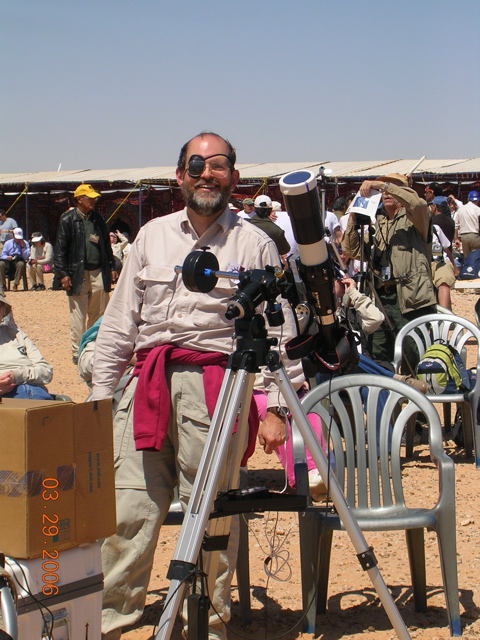
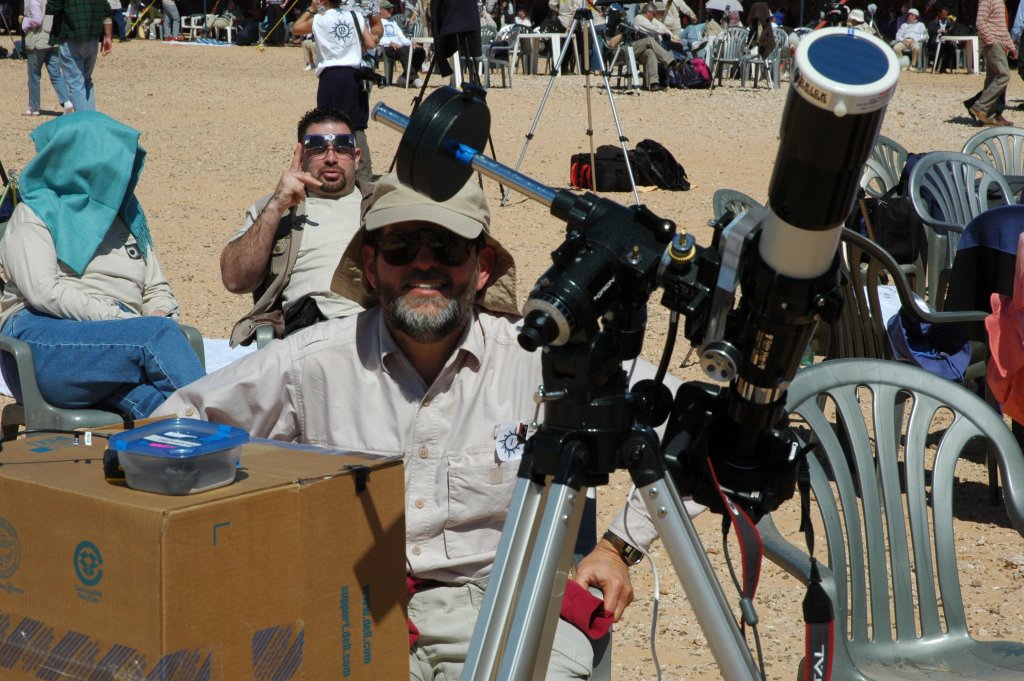
Courtesy of the Felds
Courtesy of Chris
Erickson
Thus it meant
- The camera had to be fully computer controlled
- The telescope needed to be on a tracking mount so minimal
adjustments would be required during totality. (In practice I gave the
dec adjustment a single tweek about 1 minute into totality)
Computer controlling the camera was high risk, but it also meant the
possibility of capturing far more pictures. I started evaluating
various image capture programs last fall. Right from the start ImagesPlus was the clear
favorite. The author worked up a version (which eventually became
2.75) that was capable of taking a shot about every 3 seconds.
For a 4 minute eclipse this presented the possibility of capturing over
60 images of totality.
My old digital camera did not permit computer control (it did not even
have a blub port). So I decided to get the Canon 20Da. This
is a standard camera that has a number of modifications for
astrophotography including higher sensitivity to H-alpha. It can be
fully controlled using a USB cable.
For a telescope I chose a TeleVue 76. This is a relatively small
APO and it mates well with the 20Da. The combination yielded an
effective focal length of 768 mm at f/ 6.3.
The tracking mount was an Orion EQ-3. This is not a very high
quality mount if it is being used for astrophotography, but it proved
more than adequate for my use in Libya. I did a rough polar
alignment the night before the eclipse at the tent site. When we moved
the next day I aligned it using a compass.
The capture scenario, the thinking that went into it, and the results
are a whole other discussion. I will revise this web page
sometime in late April to cover this topic.
There were also some detailed items such as using an existing Atlas
case as a suitcase/field table. Using a box that fit inside the
case to shield the laptop from the sun. I bought a low end
handheld GPS that allow me to sync the laptop to the correct time and
(at least I was supposed to) also sync the camera to GPS time.
Finally I bought a small program
that made voice announcements during
the eclipse. This was useful, but less so than in practice
sessions since it got very nosy during totality.
Images were processed with a combination of the Canon EOSViewer
Utility, ImagesPlus, and Photoshop CS.
to send feedback or for more information.

All photos and text concerning the Libya 2006 Eclipse by Robert J. Hawley
is licensed under a Creative
Commons Attribution-Noncommercial-Share Alike 3.0 United States License.
This permits the non commercial use of the material on this site,
either in whole or in part, in other works provided that I am credited
for the work.
rjh 2/24/08







